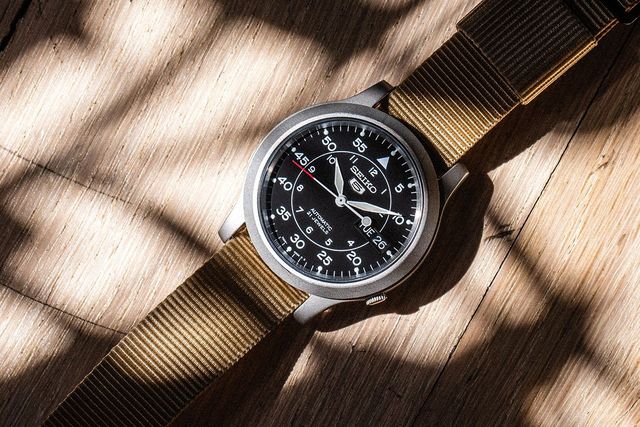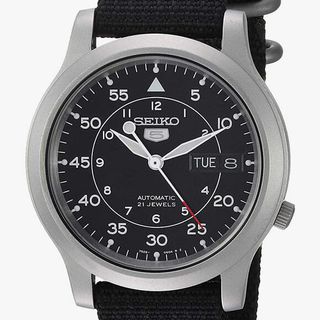Welcome to Watches You Should Know, a biweekly column highlighting important or little-known watches with interesting backstories and unexpected influence. This week: the Seiko 5.
The Seiko 5 isn’t just one watch. Instead, hundreds of watches with different designs, intended for different uses, have carried the emblematic shield logo with the 5 in the center. In fact, the watches have been signed several different ways — Seiko 5, Seiko 5 Sports, Seiko Sportsmatic 5, Seiko 5 Actus — and used a range of different automatic movements.
When it was introduced in 1963, the Seiko Sportsmatic 5 heralded multiple innovations. The first was the Diaflex mainspring, Seiko’s unbreakable mainspring. Another was the Diashock shock-resistant design, Seiko’s answer to the Swiss Incabloc system. Yet another was overall water resistance — although in those days the words “water proof” were used (a labeling that would have the Federal Trade Commission scrambling their lawyers if it occurred today). In any case, this third attribute was less a technological innovation and more an innovative design criteria for the Seiko 5 sub-brand.
So what does the “5” mean anyway? There is some disagreement. Tradition (and many an online watch forum entry) says it’s for the following five key attributes of all Seiko 5 watches:
1.The Diaflex mainspring
2.The Diashock system
3.Automatic winding
4.Day/date indication
5.Water resistance
(Some sources combine Diaflex and Diashock while separating Day and Date.)
However, Seiko’s website states a slightly different, somewhat more general set of attributes:
1.Automatic winding
2.Day/date displayed in a single window
3.Water resistance
4.Recessed crown at the 4 o’clock position
5.Durable case and bracelet
It’s interesting that Seiko doesn’t specifically state the Diaflex and Diashock systems — or overall movement durability — in their list. Perhaps this is because the two movements, while significant, were not unique to the Seiko 5. To us however, movement durability seems a bit more important than the location of the crown.
Over decades of production, many different movements have powered the watches carrying the Seiko 5 badge — sometimes different movements in a single model at the same time. They were designed primarily for mass production using the latest in manufacturing technology; there are those who maintain the movements are not touched by human hands at all during assembly, the very antithesis of what aficionados have come to envision as modern watchmaking.
This array later settled down to the 7S25/7S26/7S35/7S36 movements (day/date variations and number of jewels — 21 vs. 23 — are the cause of the differing calibre designations). These movements are iconic in and of themselves, and have been the motor inside a wide range of modern Seiko timepieces. In short, the Seiko 5 has always had a movement that, while not pretty, is a game-day piece, running year in and year out for decades with a minimum of fuss or maintenance. This is particularly favorable for a watch intended for the markets of Southeast Asia where maintenance facilities may have been at a premium.
Guys Love Their Seiko 5s
Get on any of the major watch forums and you’ll find scores of threads about the Seiko 5. Many posters are looking to buy, sell or trade. Some are looking for parts for repair or modifying. A few are looking for purchasing advice, and others are just showing off new acquisitions. In short, guys who love their Seiko 5s are as varied as the watch itself.
The 5 enjoys a status as a watch for daily wear, called a “daily beater” by many (we cringe a bit at the moniker, even if it is accurate). It comes in dozens of styles, from dress to diver and everything in between. That fact, combined with a very attractive price point, allows one to have multiple “beaters.”
There’s also quite a “modding” subculture: guys who, like shade-tree mechanics of old, modify their Seiko 5s to their liking. The sheer numbers of watches out there, along with the numerous movements used, provide plenty of parts for modifying to give homage to other, more expensive watches, e.g. Blancpain’s Fifty Fathoms and Omega’s Aqua Terra.
An added bonus of mass produced movements is the economy of scale. A typical Seiko 5 watch costs well under $500; you can readily find a vintage or model for less than $100 on eBay or Amazon. In fact, this author wears a vintage Seiko 5 manufactured in June of 1968 and purchased several years ago on eBay for less than $30, shipping included. eBay and online retailers are often the best ways to obtain many Seiko 5 variants, new or vintage, since distribution was always spotty at best in the United States; the sub-brand was sold mostly in Southeast Asia and parts of Latin America.
Because winding efficiency was quite good (Seiko’s invention, the “magic lever”, allows the mainspring to be wound whether the rotor is twirling clockwise or counterclockwise), the wearer doesn’t really need to use the crown to wind the watch. A few shakes are all that’s needed to get the watch running, and normal motion as wearers go about their day keeps it running.
This development reduced part counts and eased manufacturing by eliminating the keyless works, which is the mechanism that allows the wearer to manually wind a watch. With winding unnecessary, and only a seldom need to change the time, designers tucked the crown under the lip of the bezel at 4:00 and gave the watch a uniquely clean appearance. This cleanliness lent to eminent legibility; Seiko furthered this by including both day and date displays in one window at 3:00.
But what about the overall design of the Seiko 5? The watch was, first and foremost, designed to appeal to the new revolutionary generation of young people in the 1960s. Its appearance aptly parted ways with the old school, and is still sharp today. The day-date window is typically framed with a steel bezel, and the hands are often a tapered stick design.
Many if not most cases are tonneau-shaped with lugs flowing smoothly into the overall profile. Perhaps more importantly, Seiko created a watch that went where its wearers went, wet or dry, wild or sedate — thus, the emphasis on water and shock resistance. Indeed, this was the antithesis to a 1940s or ’50s watch that wasn’t waterproof and needed to visit the jewelers for a thorough cleaning every few years.
The biggest drawbacks to the Seiko 5 in the eyes of many are the bracelets, made with pressed and formed links rather than solid ones. Again, this is a concession to manufacturing and economy. Still, such bracelets are fully functional, usually look great from a design standpoint, and typically perform flawlessly.
Therein lies the real beauty of the Seiko 5. It’s a flawlessly performing timepiece with a mechanical manufacture movement, made by a company whose president & CEO is directly descended from the founder — and the thing will run practically forever with little or no maintenance. To be blunt, that’s more than can be said for some watches 100 times more expensive.
Hiroshi Nakahara, a director of the Seiko Watch Corporation, has said “We will always take pride in the words ‘Japanese manufacture,’ which indicate Seiko’s sincere determination to manufacture truly practical watches for each customer. It’s not the easy way. It’s the best way.” What else do you need to hear?
Though the classic models primarily discussed here are no longer mentioned by the brand as currently still produced, Seiko resurrected the line in 2019 with upgrades like a modern movement with hand winding and hacking, as well as refined production and finishing. It's a worthy continuation of its humble but venerable name, and shows that the brand hasn't left its core fans behind as it's climbed in price point. We hope the Seiko 5 is just getting started.




















